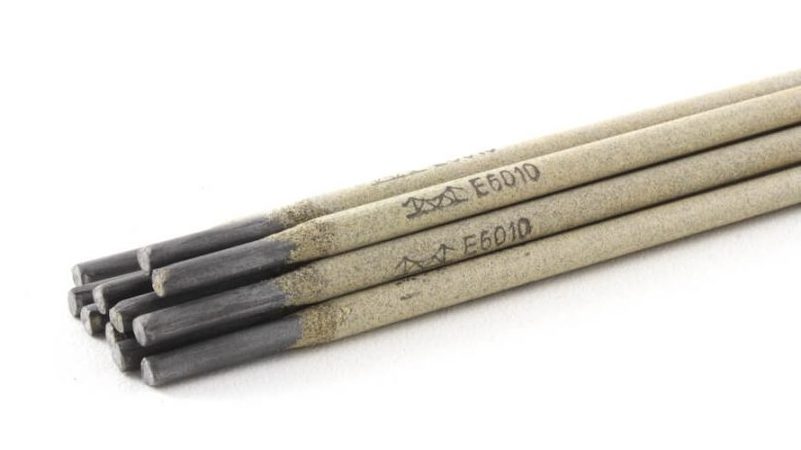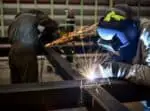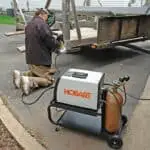Whether you are someone who frequently welds or a novice welder who welds a few times a year, one thing is certain that stick welding is indeed difficult.
Along with welding technique, one also needs some knowledge of stick electrodes which are also called welding rods.
And since factors like storage methods, diameter of the rod, and flux composition all influence stick rod selection and its performance and efficiency, equipping yourself with some information will help you eliminate misunderstanding and improve your stick welding success.

The six types of welding rods that are the most often used in the welding business are-
- 6010 electrodes that are used to deliver deep penetration.
- 6011 electrodes that can be used on either alternating or direct current.
- 6012 is a general-purpose welding rod.
- 6013 generates a soft arc with little splatter.
- 7018 is primarily used for low to moderate carbon steel welding.
- 7024 welding rod that is distinguished by its high iron powder content.
Okay so let us understand these different electrodes in detail-
1. E6010
E6010 stick welding rod is basically composed of cellulose and is primarily used for pipeline welding root weld operations since it does not create a lot of slag. As a result, cleaning is one less work for the welder.
It provides deep penetration with enough dilution and is excellent for out-of-position welding properties.
Another reason is the E6010 rod’s high force arc, which ensures full penetration while welding the root run.
However, only direct current (DC) power sources can be utilised with E6010 electrodes.
2. E6011
The E6011 stick electrode is a well-known fast-freeze type of electrode. As a fast-freeze welding rod, they may be utilized for all welding types.
The E6011 electrode’s flux coating enables for both DCEP and AC power supply and this electrode is a general-purpose welding rod that may be used for both maintenance and manufacture.
It is generally used to weld mild steels, galvanized steels, and some low alloy steels.
The E6011 has comparable characteristics to the E6010, however it has the advantage of being able to run on both AC and DC current, making it suitable with both small AC and DC welders.
3. E6012
This electrode has excellent starting properties and may be used for all common welding applications such as structural steel, wrought iron gates, galvanised steel, and thinner sections.
They are usually recommended for inexperienced welders because of their ease of usage. They are versatile, easy to hit, and a single amperage may be used for a variety of positions.
4. E6013
This is a popular stick welding electrode which is used for sheet metal, general fabrication, and structural welding applications.
E6013 electrodes feature a gentle arc with minimum spatter, moderate penetration, and a slag that is readily removed.
E6013 electrodes are extremely similar to E6012 electrodes, but E6013 differs in coating, slag generation, and welding polarity.
Both E6012 and E6013 can be used with DCEP polarity, however only the E6013 may also be utilised with AC and DCEN polarity.
5. E7018
E7018 is a popular SMAW/stick welding low hydrogen electrode for mild steel and carbon steel welding.
These electrodes are utilised for moderate strength applications and are suitable for connecting all mild steels, low carbon steels, and medium carbon steels without causing any weldability concerns.
The E7018 electrodes may be utilised with both AC and DCEP polarity.
6. E7024
E7024 electrodes are used for the welding of ship constructions, bridges, and structural works to provide a high weld deposit.
In single-pass welds, it provides great weld deposit efficiency. These electrodes are much thicker than E6010, E6013, or E7018.
These electrodes are commonly used by welders for high-speed horizontal or flat fillet welds.
Classification of electrode number
For welding rod electrodes, the welding industry has used the American Welding Society’s classification number system.
The steel arc welding electrode identification system is configured as follows:
• E denotes an electrode for arc welding.
• The first two/three figures- it represents tensile strength which is the material’s resistance to forces.
The weld position is indicated by the third/fourth digit.
• 0 indicates that the classification is not used,
• 1 indicates that it is used for all positions,
• 2 indicates that it is used only for flat and horizontal positions,
• 3 indicates that it is used just for flat positions.
• The fourth or fifth digit identifies the kind of electrode coating as well as the power supply utilised (AC or DC, straight or reverse polarity).
| Electrode | Coating | Position | Current | Penetration | Tensile strength |
|---|---|---|---|---|---|
| E-6010 | Extremely high cellulose sodium | All positions | DCEP | Deep | 60,000 PSI |
| E-6011 | Potassium-rich cellulose | All positions | DCEP AC | Deep | 60,000 PSI |
| E-6012 | Extremely high titania sodium | All positions | DCEN AC | Medium | 60,000 PSI |
| E-6013 | High titania potassium | All positions | DCEP DCEN AC | Shallow | 60,000 PSI |
| E-7018 | Low powder, low hydrogen | All positions | DCEP AC | Shallow to medium | 70,000 PSI |
| E-7024 | Low powder, low hydrogen | Flat horizontal fillets | DCEN AC | Shallow to medium | 70,000 PSI |
Which electrode should you go for?
The electrode you choose depends on various factors like the metal, its thickness, power source, etc.
• First, you need to choose a stick electrode that fits the base metal’s strength qualities and composition, and also according to your welding requirement.
That is, when working on mild steel, any E60 or E70 electrode will suffice.
• Also, connect the electrode to the welding site while keeping the available power source in mind. Remember that certain electrodes can only be used with DC or AC, but others may be used with both.
• Choose an electrode with a light or soft arc, such as an E6013, for thin materials or joints with broad root apertures.
• Always go for an electrode with optimum ductility to minimise weld cracking on thick, heavy material and/or intricate joint designs.
Consider the service condition of the component as well as the standards it must satisfy.
• Consider production efficiency as well. Electrodes with a high iron powder composition, such as E7014 or E7024, provide faster deposition rates while operating in the flat position.
Always examine the welding specification and procedures for the electrode type for essential applications.
While selecting an electrode for your welding needs, there are certain things you need to consider.
Stick electrodes come in a variety of shapes and sizes, each with its own set of benefits and limitations. And when it comes to welding rod selection, there are various aspects to consider:
1.) Composition of the base metal to be welded- Your objective should be to match the electrode composition to the base metal type, which will aid in the formation of a robust as well as a good quality weld.
2.) Thickness of the base metal, form, and joint fit-up
To avoid weld cracking in thick materials, an electrode with high ductility and low hydrogen is required.
Whereas an electrode that produces mild arcs is required for thin metal welding.
3.) Welding voltage- Some electrodes can only be used with AC or DC power sources, but others may be used with both.
4.) Tensile power- The tensile strength of a stick electrode may be determined by looking at the first two digits of the AWS classification printed on the side of the electrode, and it should match the minimum tensile strength of the electrode to the tensile strength of the base metal to prevent any welding defects.
Conclusion
There are different types of stick electrodes for different purposes. And you have to go for one that suits your needs best. It is important for you to know about their functions and purposes before you decide to employ them for your welding work.






